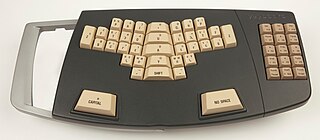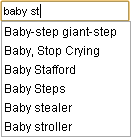Related Research Articles

A keyset or chorded keyboard is a computer input device that allows the user to enter characters or commands formed by pressing several keys together, like playing a "chord" on a piano. The large number of combinations available from a small number of keys allows text or commands to be entered with one hand, leaving the other hand free. A secondary advantage is that it can be built into a device that is too small to contain a normal-sized keyboard.

Morse code is a method used in telecommunication to encode text characters as standardized sequences of two different signal durations, called dots and dashes, or dits and dahs. Morse code is named after Samuel Morse, one of the early developers of the system adopted for electrical telegraphy.

Radioteletype (RTTY) is a telecommunications system consisting originally of two or more electromechanical teleprinters in different locations connected by radio rather than a wired link. Radioteletype evolved from earlier landline teleprinter operations that began in the mid-1800s. The US Navy Department successfully tested printing telegraphy between an airplane and ground radio station in 1922. Later that year, the Radio Corporation of America successfully tested printing telegraphy via their Chatham, Massachusetts, radio station to the R.M.S. Majestic. Commercial RTTY systems were in active service between San Francisco and Honolulu as early as April 1932 and between San Francisco and New York City by 1934. The US military used radioteletype in the 1930s and expanded this usage during World War II. From the 1980s, teleprinters were replaced by personal computers (PCs) running software to emulate teleprinters.

Shorthand is an abbreviated symbolic writing method that increases speed and brevity of writing as compared to longhand, a more common method of writing a language. The process of writing in shorthand is called stenography, from the Greek stenos (narrow) and graphein. It has also been called brachygraphy, from Greek brachys (short), and tachygraphy, from Greek tachys, depending on whether compression or speed of writing is the goal.

Velotype is the trademark for a type of keyboard for typing text known as a syllabic chord keyboard, an invention of the Dutchmen Nico Berkelmans and Marius den Outer.

A court reporter, court stenographer, or shorthand reporter is a person whose occupation is to capture the live testimony in proceedings using a stenographic machine or a stenomask, thereby transforming the proceedings into an official certified transcript by nature of their training, certification, and usually licensure. This can include courtroom hearings and trials, depositions and discoveries, sworn statements, and more.

Speed reading is any of many techniques claiming to improve one's ability to read quickly. Speed-reading methods include chunking and minimizing subvocalization. The many available speed-reading training programs may utilize books, videos, software, and seminars. There is little scientific evidence regarding speed reading, and as a result its value seems uncertain. Cognitive neuroscientist Stanislas Dehaene says that claims of reading up to 1,000 words per minute "must be viewed with skepticism".
Touch typing is a style of typing. Although the phrase refers to typing without using the sense of sight to find the keys—specifically, a touch typist will know their location on the keyboard through muscle memory—the term is often used to refer to a specific form of touch typing that involves placing the eight fingers in a horizontal row along the middle of the keyboard and having them reach for specific other keys. Both two-handed touch typing and one-handed touch typing are possible.

A steno machine, stenotype machine, shorthand machine, stenograph or steno writer is a specialized chorded keyboard or typewriter used by stenographers for shorthand use. In order to pass the United States Registered Professional Reporter test, a trained court reporter or closed captioner must write speeds of approximately 180, 200, and 225 words per minute (wpm) at very high accuracy in the categories of literary, jury charge, and testimony, respectively. Some stenographers can reach 300 words per minute. The website of the California Official Court Reporters Association (COCRA) gives the official record for American English as 375 wpm.

Typing is the process of writing or inputting text by pressing keys on a typewriter, computer keyboard, mobile phone, or calculator. It can be distinguished from other means of text input, such as handwriting and speech recognition. Text can be in the form of letters, numbers and other symbols. The world's first typist was Lillian Sholes from Wisconsin in the United States, the daughter of Christopher Sholes, who invented the first practical typewriter.

Autocomplete, or word completion, is a feature in which an application predicts the rest of a word a user is typing. In Android and iOS smartphones, this is called predictive text. In graphical user interfaces, users can typically press the tab key to accept a suggestion or the down arrow key to accept one of several.

Teeline is a shorthand system developed in 1968 by James Hill, a teacher of Pitman Shorthand. It is accepted by the National Council for the Training of Journalists, which certifies the training of journalists in the United Kingdom.
Forkner Shorthand is an alphabetic shorthand created by Hamden L. Forkner and first published in 1955. Its popularity grew through the 1980s as those who needed shorthand every day began to favor the easier learning curve of alphabetic systems to the more difficult symbol-based ones. Forkner was taught in high-schools and colleges throughout North America along with comparable shorthands such as AlphaHand, Speedwriting, Stenoscript and Personal Shorthand.

Deutsche Einheitskurzschrift is a German stenography system. DEK is the official shorthand system in Germany and Austria today. It is used for word-for-word recordings of debates in the Federal Parliament of Germany.
A speech-to-text reporter (STTR), also known as a captioner, is a person who listens to what is being said and inputs it, word for word, as properly written texts. Many captioners use tools which commonly converts verbally communicated information into written words to be composed as a text. The reproduced text can then be read by deaf or hard-of-hearing people, language learners, or people with auditory processing disabilities.

TypeRacer is a multiplayer online browser-based typing game. In TypeRacer, players complete typing tests of various texts as fast as possible, competing against themselves or with other users online. It was launched in March 2008.
A copy typist is someone who specializes in typing text from a source which they read. Originally appeared as a skill in handling of typewriter, later it transitioned to using computer keyboard with results tracking on computer display and obtaining using printer. Before introduction of computers, an additional skill of proofreading and document editing were critical.
Speech tempo is a measure of the number of speech units of a given type produced within a given amount of time. Speech tempo is believed to vary within the speech of one person according to contextual and emotional factors, between speakers and also between different languages and dialects. However, there are many problems involved in investigating this variance scientifically.
Stephen Peter Woodmore was a British electronics salesman known for his rapid speech articulation, being able to articulate 637 words per minute (wpm), a speed four times faster than the average person. Woodmore was listed by the Guinness Book of World Records as the world's fastest talker, taking the helm from the previous record holder, John Moschitta Jr., in August 1990. Woodmore lost his record in 1995, when Sean Shannon from Canada was able to articulate 655 wpm.

Barbara Clay Henley Blackburn was an American clerical worker recognized for her claimed fast typing speed using the Dvorak keyboard layout.
References
- ↑ Ahmed Sabbir Arif and Wolfgang Stuerzlinger. 2009."Analysis of Text Entry Performance Metrics Archived 2015-09-23 at the Wayback Machine ". In Proceedings of the IEEE Toronto International Conference–Science and Technology for Humanity (TIC-STH '09). IEEE, Washington, D.C., US, pp. 100-105.
- ↑ Karat CM, Halverson C, Horn D, Karat J (1999). "Patterns of entry and correction in large vocabulary continuous speech recognition systems". Proceedings of the SIGCHI conference on Human Factors in Computing Systems (CHI '99). New York, NY, US: ACM. pp. 568–575. doi:10.1145/302979.303160. ISBN 0-201-48559-1.
- ↑ Ayres, Robert U; Martinás, Katalin (2005), "120 wpm for very skilled typist", On the Reappraisal of Microeconomics: Economic Growth and Change in a Material World, Cheltenham, UK & Northampton, Massachusetts: Edward Elgar Publishing, p. 41, ISBN 978-1-84542-272-1 , retrieved 22 November 2010
- ↑ Brown, C. Marlin (1988). Human-computer interface design guidelines. USA: Ablex Pub. Corp. ISBN 0893913324.
- ↑ "Fastest realtime court reporter (stenotype writing)". Guinnessworldrecords.com. 2004-07-30. Retrieved 2014-05-13.
- ↑ Hardcastle, R. A.; Matthews, C. J. (January 1991). "Speed of writing". Journal of the Forensic Science Society. 31 (1): 21–29. doi:10.1016/s0015-7368(91)73114-9.
- ↑ Zaviani, Jenny; Wallen, Margaret (2006). "The Development of Graphomotor Skills". In Henderson, Anne; Pehoski, Charlane (eds.). Hand Function in the Child: Foundations for Remediation (2nd ed.). St. Louis, MO: Mosby. p. 228. ISBN 0323031862.
- ↑ "New World'S Record For Shorthand Speed" (PDF). New York Times. 1922-12-30. Retrieved 2014-05-13.
- ↑ Trauzettel-Klosinski, Susanne; Dietz, Klaus (August 2012). "Standardized Assessment of Reading Performance: The New International Reading Speed Texts IReST". Investigative Ophthalmology & Visual Science. 53 (9): 5452–61. doi: 10.1167/iovs.11-8284 . PMID 22661485.
- ↑ Bremer, Rod (2016-01-20). The Manual: A Guide to the Ultimate Study Method (2 ed.). Fons Sapientiae Publishing. ISBN 978-0-9934964-0-0.
- ↑ Ziefle, M (December 1998). "Effects of display resolution on visual performance". Human Factors. 40 (4): 554–68. doi:10.1518/001872098779649355. PMID 9974229. S2CID 33065301.
- ↑ Williams, J. R. (1998). Guidelines for the use of multimedia in instruction, Proceedings of the Human Factors and Ergonomics Society 42nd Annual Meeting, 1447–1451
- ↑ Wong, Linda (2014). Essential Study Skills. Cengage Learning. ISBN 978-1285965628.
- ↑ Chafets, Zev (2006-03-19). "Ministers of Debate". The New York Times.
- ↑ Smillie, Dirk (2008-07-22). Falwell Inc.: Inside a Religious, Political, Educational, and Business Empire - Dirk Smillie - Google Boeken. Macmillan. ISBN 9780312376291 . Retrieved 2014-04-20.
- ↑ Huzeyfe Bilge (September 2019). Okuma, Yazma ve Konuşmada Akıcılık ile Okuduğunu Anlama ve Kelime Hazinesi Arasındaki İlişki [The Relationships between Reading, Writing and Speaking Fluencies, Reading Comprehension and Vocabulary] (PhD) (in Turkish). Gazi University. Retrieved 29 August 2023.
- ↑ Ender Ateşman (August 1997). "Türkçede Okunabilirliğin Ölçülmesi" [Measuring Readability in Turkish](PDF). Dil Dergisi (Language Journal) (in Turkish): 71–74. Retrieved 29 August 2023.
- ↑ Bezirci, Burak; Yılmaz, Asım Egemen (October 2010). "Metinlerin Okunabilirliğinin Ölçülmesi Üzerine Bir Yazılım Kütüphanesi ve Türkçe İçin Yeni Bir Okunabilirlik Ölçütü" [A Software Library for Measurement of Readability of Texts and A New Readability Metric For Turkish]. Dokuz Eylül Üniversitesi Mühendislik Fakültesi Fen ve Mühendislik Dergisi (in Turkish). 12 (3): 49–62.
- ↑ Rudolf Flesch. "Chapter 2: Let's Start With the Formula" . Retrieved 29 August 2023.
- ↑ "John Moschitta set record for fast talking... May 24 in History". Brainyhistory.com. 1988-05-24. Retrieved 2014-04-20.
- ↑ "World's Fastest Talker - Steve Woodmore". YouTube. 2011-02-05. Archived from the original on 2021-12-12. Retrieved 2014-04-20.
- ↑ "How fast should I sign?". American Sign Language University. 2014-02-09. Retrieved 2020-07-30.
- ↑ International Telecommunication Union, ITU. "International Morse Code Recommendation" (PDF). ITU.
- ↑ Morsh, Joseph E.; Stannard, A. F. B. (1947). "Studies in international Morse Code. II. A simplified method of determining code speed". Canadian Journal of Psychology. 1 (2): 67–70. doi:10.1037/h0084027.
- ↑ Morse Code at 140 WPM
- ↑ Commercial Radio Operator Types of Licenses
- ↑ "Morse code page of Roger J. Wendell - WBŘJNR (WB0JNR)". Rogerwendell.com. Retrieved 2014-04-20.